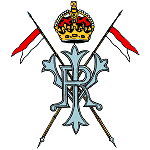21st Lancers
| 21st Lancers (Empress of India's) | |
|---|---|
 |
|
| Active | 1858–1921/1922 |
| Country |
|
| Type | Cavalry |
| Colours | Dark blue uniform with French grey facings, white plume |
| Engagements |
Mahdist War First World War North-West Frontier |
The 21st Lancers (Empress of India's) was a cavalry regiment of the British Army, raised in 1858 and amalgamated with the 17th Lancers in 1922 to form the 17th/21st Lancers. Perhaps its most famous engagement was the Battle of Omdurman, where Winston Churchill (then an officer of the 4th Hussars), rode with the unit. It amalgamated with the 17th Lancers, to form the 17th/21st Lancers in 1922.
The regiment was originally raised in Bengal by the East India Company in 1858 as the 3rd Bengal European Light Cavalry, for service in the Indian Rebellion. As with all other "European" units of the Company, it was placed under the command of the British Crown in 1858, and formally moved into the British Army in 1862, when it was designated as a hussar regiment and titled the 21st Regiment of Hussars. A detachment saw service in the 1884–5 expedition to the Sudan, with the Light Camel Regiment. In 1897 it was re-designated as a lancer regiment, becoming the 21st Lancers. The Indian origin of the regiment was commemorated in its "French grey" facings - this distinctive light blue/grey shade having previously been the uniform colour of the East India Company's eight regiments of Bengal Native Cavalry.
In 1898 the regiment served in Sudan during the Mahdist War, as the only British cavalry unit involved. It was there that the full regiment charged with lances in the classic cavalry style during the Battle of Omdurman in September 1898. Of less than 400 men involved in the charge 70 were killed and wounded and the regiment won three Victoria Crosses. These three were Private Thomas Byrne, Lieutenant Raymond de Montmorency and Captain Paul Kenna. This spectacular encounter earned considerable public attention and praise for the regiment, though it was also criticized as a costly and unnecessary anachronism - since the 2,000 Dervish spearmen dispersed by the 21st Lancers could have been destroyed by rifle fire with few if any British losses.Winston Churchill (then an officer of the 4th Hussars), rode with the unit.
...
Wikipedia
